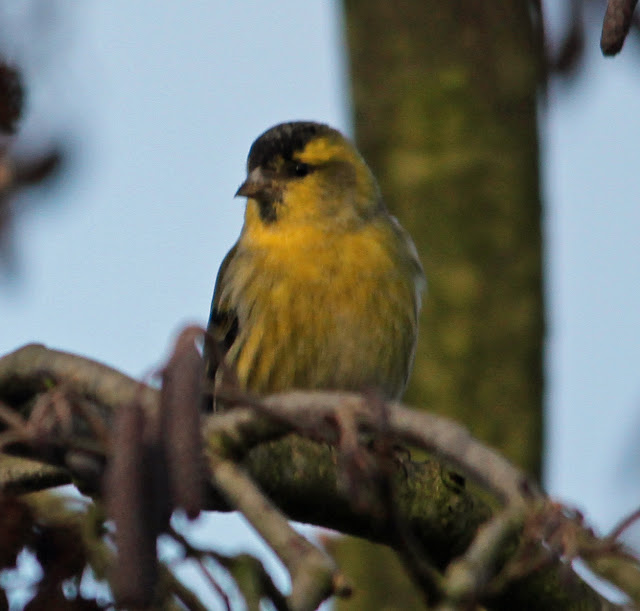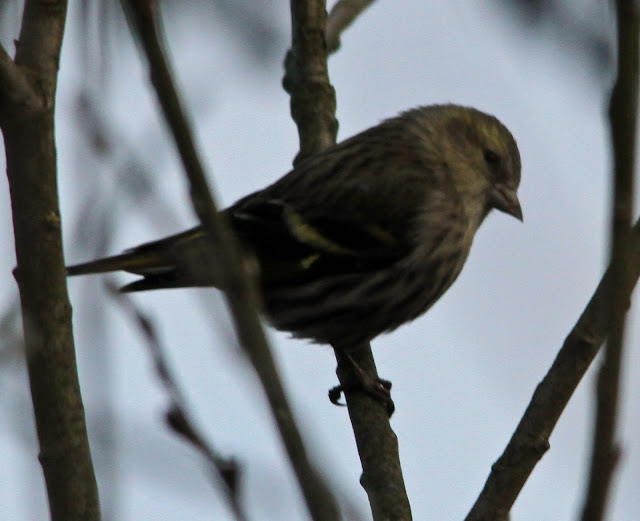It was a bit brighter this morning, so before I headed off to North Wales to return Nain to her home in time for New Year, I went back to the Access trail to look for the Siskins and any Lesser Redpolls that I might try to find.
I should have taken my tripod, and certainly missed it once I was on site - the lens really is too heavy to get good photos - I also REALLY need to sort out my ISO number and exposure settings to get better photos.
Here is a shot of a male Siskin, Carduelis spinus, that came fairly close, but it still looks very grainy. The size of the black bib is said to relate to the dominance status of the bird.
The black cap is made more emphatic in displays by the raising of the head feathers. Other displays include wing lowering to reveal the yellow rump and wing stripe. Males may also make circular flights off tall vantage points with slowly fluttering wings, twittering while they do so - possibly in the breeding season? Pairing should take place over the winter period before migration. Nesting may take place in small groups of say 6 pairs, in conifers.
Siskins tend to winter in very different places in different winters, perhaps looking for different supplies of seed crops.
This is likely to be a different bird:
And this is the same bird as immediately above, but with the picture variously enhanced:
And this is a female or immature I think:
This shot from ARKIVE on the web shows the yellow stripes on the primary wing feathers of the adults? These are the characteristics said by the Barcelona/Manchester group of researchers to be both signs of independent foraging ability and also related to sexual selection by the females. You can see the major coverts to the top of this amazing photo.

This close-up shot of mine shows the secondaries and primaries each with their yellow stripes, partrly hidden I think by the greater coverts while at rest.
I should have taken my tripod, and certainly missed it once I was on site - the lens really is too heavy to get good photos - I also REALLY need to sort out my ISO number and exposure settings to get better photos.
Here is a shot of a male Siskin, Carduelis spinus, that came fairly close, but it still looks very grainy. The size of the black bib is said to relate to the dominance status of the bird.
The black cap is made more emphatic in displays by the raising of the head feathers. Other displays include wing lowering to reveal the yellow rump and wing stripe. Males may also make circular flights off tall vantage points with slowly fluttering wings, twittering while they do so - possibly in the breeding season? Pairing should take place over the winter period before migration. Nesting may take place in small groups of say 6 pairs, in conifers.
Siskins tend to winter in very different places in different winters, perhaps looking for different supplies of seed crops.
This is likely to be a different bird:
And this is the same bird as immediately above, but with the picture variously enhanced:
And this is a female or immature I think:
This shot from ARKIVE on the web shows the yellow stripes on the primary wing feathers of the adults? These are the characteristics said by the Barcelona/Manchester group of researchers to be both signs of independent foraging ability and also related to sexual selection by the females. You can see the major coverts to the top of this amazing photo.
This close-up shot of mine shows the secondaries and primaries each with their yellow stripes, partrly hidden I think by the greater coverts while at rest.








No comments:
Post a Comment